Exam (elaborations)
Test Bank for Bontragers Textbook of Radiographic Positioning and Related Anatomy 10th Edition by Lampignano Chapter 1-20
- Course
- Institution
Test Bank for Bontragers Textbook of Radiographic Positioning and Related Anatomy 10th Edition by Lampignano Chapter 1-20
[Show more]








